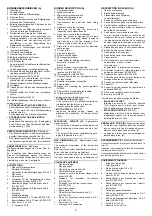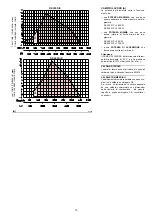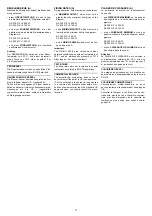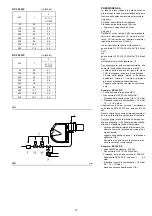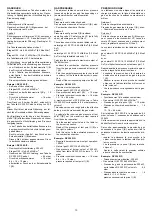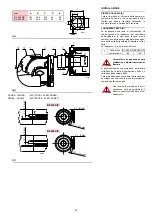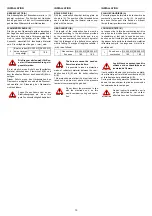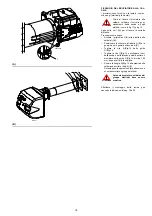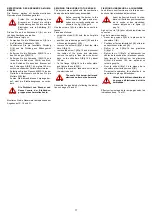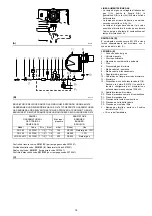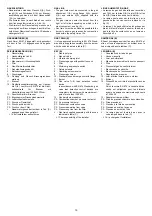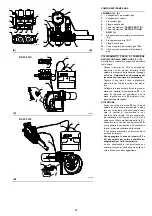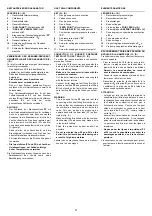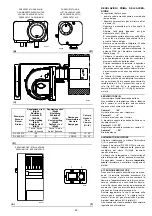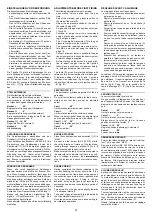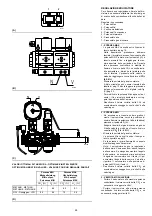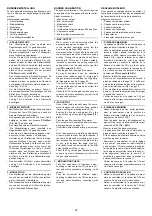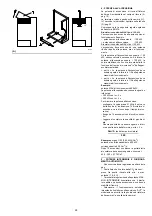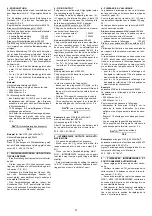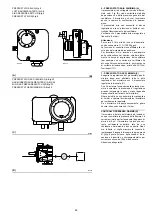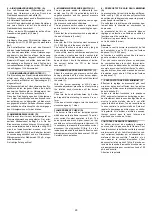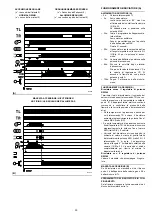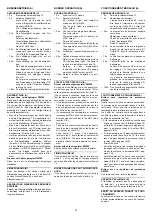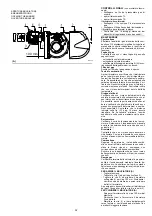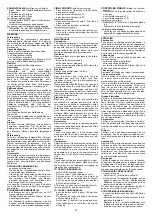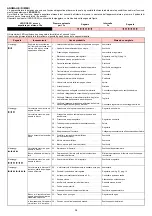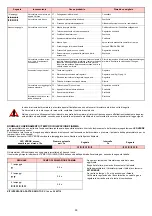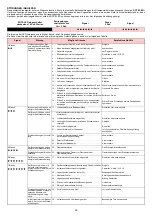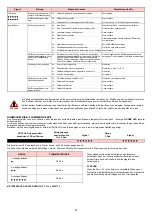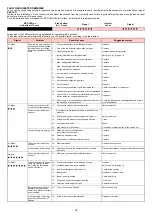
23
EINSTELLUNGEN VOR DER ZÜNDUNG
Die auszuführenden Einstellungen sind:
- handbetätigte Ventile vor der Gasarmatur öff-
nen.
- Den Gas-Mindestdruckwächter auf den Ska-
lenanfangswert (A) einstellen.
- Den Luft-Druckwächter auf den Skalenend-
wert (5 mbar) (B) einstellen.
- Die Luft mittels Schraube 11)(A)S.20 aus der
Gasleitung entlüften. Es wird empfohlen, die
abgelassene Luft über einen Kunststoff-
schlauch ins Freie abzuführen, bis der Gas-
geruch wahrnehmbar ist.
- Ein digitales U- Rohr-Manometer (C) auf den
Gasanschluß der Muffe einbauen.
Hiermit wird die ungefähre Höchstleistung
des Brenners anhand der Tabellen auf Seite
12 ermittelt.
- Eine Glühbirne oder einen Tester zum Gas-
Magnetventil parallelschalten, um den Zeit-
punkt der Spannungszufuhr zu überprüfen.
Vor dem Zünden des Brenners sind die Gas-
armaturen so einzustellen, daß die Zündung
unter Bedingungen höchster Sicherheit bei
einem geringen Gasdurchsatz erfolgt.
Die Tabelle (D) gibt die Einstellungen für die
erste Zündung an einem mit Erdgas funktionie-
renden Brenner an. In ihr sind die Einstellungen
der Schrauben N und V am Ventilkörper (abb.
B-C Seite 24) sowie die Stellung des Zündnok-
kens (III – IV) (fig. E) des Stellantriebs angege-
ben.
STELLANTRIEB (E)
Der Stellantrieb steuert die Luftklappe.
Die werkseitige Einstellung seiner 4 Nocken
nicht verändern; es sollte nur die Entsprechung
zu folgenden Angaben überprüft werden:
Nocken I
: 90°
Begrenzt die Drehung zum Höchstwert.
Nocken I I
: 0°
Begrenzt die Drehung zum Mindestwert.
Bei ausgeschaltetem Brenner müßt die Luft-
klappe geschlossen sein: 0°.
Nocken I I I - I V: 20°
Regelt die Zünd (> camma V).
Nocken V
: 20°
Mindestleistung.
ANFAHREN DES BRENNERS
Die Fernsteuerungen einschalten und den
Schalter 1)(F) in Stellung “MAN” setzen.
Nach Anfahren des Brenners (RX 500 S/P) die
Drehrichtung des Gebläserades durch das
Sichtfenster 13)(A)S. 8 überprüfen (gegen den
Uhrzeigersinn im Vergleich zum Motor). Prüfen,
dass an der am Magnetventil angeschlossenen
Glühbirne bzw. am Tester keine Spannung
anliegt. Wenn Spannung vorhanden ist, sofort
den Brenner ausschalten und die Elektroan-
schlüsse überprüfen.
ZÜNDUNG DES BRENNERS
Wenn alle vorab angeführten Anleitungen
beachtet worden sind, müßte der Brenner zün-
den. Wenn hingegen der Motor läuft, aber die
Flamme nicht erscheint und eine Geräte-Störab-
schaltung erfolgt, entriegeln und das Anfahren
wiederholen. Sollte die Zündung immer noch
nicht stattfinden, könnte dies davon abhängen,
daß das Gas nicht innerhalb der vorbestimmten
Sicherheitszeit 3 s den Flammkopf erreicht. Die
Schraube N am Gasventil etwas in Richtung “+”
drehen und das Anfahren wiederholen. Das
digitale U-Rohr-Manometer (C) zeigt den
Gaseintritt an der Muffe an.
Nach erfolgter Zündung den Brenner vollständig
einstellen.
ADJUSTMENTS BEFORE FIRST FIRING
The following adjustments must be made:
- open manual valves up-line from the gas
train.
- Adjust the minimum gas pressure switch to
the start of the scale (A).
- Adjust the air pressure switch at the end of
the scale (5 mbar) (B).
- Purge air from the gas line by means of screw
11)(A)p.20.
Continue to purge the air (we recommend
using a plastic tube routed outside the build-
ing) until gas is smelt.
- Fit a U-type/digital manometer (C) to the gas
pressure test point on the manifold.
The manometer readings are used to calcu-
late MAX. burner power using the tables on
page 12.
- Connect a lamp or tester in parallel to the gas
line solenoid valve to check the exact moment
at which voltage is supplied.
Before starting up the burner it is good prac-
tice to adjust the gas train so that ignition
takes place in conditions of maximum safety,
i.e. with gas delivery at the minimum.
The table (D) gives first start-up settings with
reference to a burner fuelled with methane gas.
It features settings of the N and V screws
located on the valve body (fig. B-C pag. 24) and
the position of the servomotor's ignition cam (III
- IV) (fig. E).
SERVOMOTOR (E)
The servomotor provides adjustment of the air
gate valve.
Do not alter the factory setting for the 4 cams;
simply check that they are set as indicated
below:
Cam I
: 90°
Limits rotation toward maximum position.
Cam I I
: 0°
Limits rotation toward the minimum position.
When the burner is shut down the air gate valve
and the gas butterfly valve must be closed: 0°.
Cam I I I - I V
: 20°
Adjusts the ignition position (> camma V).
Cam V
: 20°
Minimum output.
BURNER STARTING
Close the control devices and set switch 1)(F) to
“MAN”.
As soon as the burner (RX 500 S/P) starts,
check the direction of rotation of the fan blade,
looking through inspection window 13)(A) p. 8
(anticlockwise with respect to the motor).
Make sure that the lamp or testers connected to
the solenoid valve indicate that there is no volt-
age. If voltage is present, then
immediately
stop the burner and check electrical connec-
tions.
BURNER FIRING
Having completed the checks indicated in the
previous heading, the burner should fire. If the
motor starts but the flame does not appear and
the control box goes into lock-out, reset and wait
for a new firing attempt. If firing is still not
achieved, it may be that gas is not reaching the
combustion head within the safety time period of
3 seconds.
Turn screw N on the gas valve slightly towards
“+” and repeat start-up.
The arrival of gas at the manifold is indicated by
the U-type/digital manometer (C).
Once the burner has fired, now proceed with glo-
bal calibration operations.
RÉGLAGES AVANT L'ALLUMAGE
Les réglages à faire sont les suivants:
- ouvrir les vannes manuelles situées en amont
de la rampe du gaz.
- Régler le pressostat gaz minimum en début
d’échelle (A).
- Régler le pressostat air en fin d’echelle (5
mbar) (B).
- Purger l’air du tuyau du gaz à l’aide de la vis
11)(A)p.20.
Il est conseillé d’évacuer l’air purgé en dehors
des locaux par un tuyau en plastique jusqu’à
ce que l’on sente l’odeur caractéristique du
gaz.
- Monter un manomètre en U/numérique (C)
sur la prise de pression de gaz du manchon.
Celui-ci servira à mesurer approximativement
la puissance maximum du brûleur à l’aide du
tableau page 12.
- Brancher une ampoule ou un testeur en
parallèle à l’électrovanne du gaz pour contrô-
ler le moment de la mise sous tension.
Avant d’allumer le brûleur, régler la rampe du
gaz afin que l’allumage se fasse dans les
conditions de sécurité maximum, c’est à dire
avec un débit de gaz très faible.
Le tableau (D) indique les réglages du premier
allumage pour un brûleur fonctionnant avec du
gaz méthane. Il reporte également le réglage
des vis N et V se trouvant sur le corps de la
vanne (fig. B-C pag. 24) et la position de la
came d’allumage (III – IV) (fig. E) du servomo-
teur.
SERVOMOTEUR (E)
Le servomoteur règle le volet d’air.
Ne pas modifier le réglage des 4 cames équi-
pant l’appareil effectué en usine. Contrôler sim-
plement que ces cames soient réglées comme
suit:
Came I
: 90°
Limite la rotation vers le maximum.
Came I I
: 0°
Limite la rotation vers le minimum.
Brûleur éteint, le volet de l’air et la vanne
papillon doivent être fermés: 0°.
Came I I I - I V : 20°
Règle la position d’allumage (> camma V).
Came V
: 20°
Puissance minimale.
DÉMARRAGE BRÛLEUR
Fermer les télécommandes et placer l’interrup-
teur 1)(F) en position “MAN”.
Dès que le brûleur (RX 500 S/P) démarre con-
trôler le sens de rotation du rotor de la turbine
du ventilateur par le viseur 13)(A) page 8 (sens
inverse aux aiguilles d’une montre par rapport
au moteur). Vérifier si l’ampoule ou le testeur
branché à l’électrovanne indique qu’il n’y a pas
de tension
.
S’ils signalent une tension, arrêter
immédiatement le brûleur et contrôler les rac-
cordements électriques.
ALLUMAGE BRÛLEUR
Après avoir effectué les opérations décrites au
point précédent, le brûleur devrait s’allumer. Si
le moteur démarre mais la flamme n’apparaît
pas et le boîtier de contrôle se bloque, réarmer
et faire une nouvelle tentative de démarrage. Si
l’allumage ne se fait pas, il se peut que le gaz
n’arrive pas à la tête de combustion dans le
temps de sécurité de 3 s.
Tourner légèrement la vis N qui se trouve sur la
vanne gaz dans le sens “+” et répéter le démar-
rage. L’arrivée du gaz au manchon est indiquée
par le manomètre en U/numérique (C).
Quand l’allumage est fait, passer au réglage
complet du brûleur.
Summary of Contents for RX 350 S/P
Page 2: ......
Page 49: ...43 0 1 2 3 3 3 4 3 5 3 3 3 3 3 3 3 3 3 3 4 3 RX 350 S P...
Page 50: ...44 0 1 1 1 2 1 3 1 1 1 1 1 1 1 1 1 1 2 1 445 RX 500 S P...
Page 53: ...47 0 0 0 1 0 2 0 0 0 0 0 0 0 0 0 0 1 0 RX 350 S P...
Page 54: ...48 0 0 0 1 0 2 0 0 0 0 0 0 0 0 0 0 1 0 RX 500 S P...
Page 55: ...49 0 0 1 2 3 45 6 6 67 8 8 0 8 8 9 8 6 6 6 6 6 6 6...
Page 61: ......
Page 62: ......
Page 63: ......

